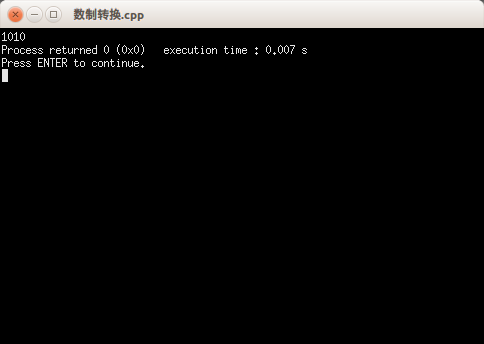栈和队列(一)——栈的实践(2)——数制转换
2015-11-15 21:57
381 查看
/* *Copyright (c) 2015 , 烟台大学计算机学院 *All right resvered . *文件名称: 数制转换.cpp *作 者: 郑兆涵 *栈和队列(一)——栈的实践(2)——数制转换 */
问题:把十进制的整数转换为任一进制数输出。请利用栈设计算法,并实现程序。
编程代码:
//头文件:sqstack.h,包含定义顺序栈数据结构的代码、宏定义、要实现算法的函数的声明
#ifndef SQSTACK_H_INCLUDED
#define SQSTACK_H_INCLUDED
#define MaxSize 100
typedef int ElemType;
typedef struct
{
ElemType data[MaxSize];
int top; //栈指针
} SqStack; //顺序栈类型定义
void InitStack(SqStack *&s); //初始化栈
void DestroyStack(SqStack *&s); //销毁栈
bool StackEmpty(SqStack *s); //栈是否为空
int StackLength(SqStack *s); //返回栈中元素个数——栈长度
bool Push(SqStack *&s,ElemType e); //入栈
bool Pop(SqStack *&s,ElemType &e); //出栈
bool GetTop(SqStack *s,ElemType &e); //取栈顶数据元素
void DispStack(SqStack *s); //输出栈
#endif // SQSTACK_H_INCLUDED
//源文件:sqstack.cpp,包含实现各种算法的函数的定义
#include <stdio.h>
#include <malloc.h>
#include "sqstack.h"
void InitStack(SqStack *&s)
{
s=(SqStack *)malloc(sizeof(SqStack));
s->top=-1;
}
void DestroyStack(SqStack *&s)
{
free(s);
}
int StackLength(SqStack *s) //返回栈中元素个数——栈长度
{
return(s->top+1);
}
bool StackEmpty(SqStack *s)
{
return(s->top==-1);
}
bool Push(SqStack *&s,ElemType e)
{
if (s->top==MaxSize-1) //栈满的情况,即栈上溢出
return false;
s->top++;
s->data[s->top]=e;
return true;
}
bool Pop(SqStack *&s,ElemType &e)
{
if (s->top==-1) //栈为空的情况,即栈下溢出
return false;
e=s->data[s->top];
s->top--;
return true;
}
bool GetTop(SqStack *s,ElemType &e)
{
if (s->top==-1) //栈为空的情况,即栈下溢出
return false;
e=s->data[s->top];
return true;
}
void DispStack(SqStack *s) //输出栈
{
int i;
for (i=s->top;i>=0;i--)
printf("%c ",s->data[i]);
printf("\n");
}
//编写main函数,进行测试。
#include <stdio.h>
#include "sqstack.h"
void MultiBaseOutput (int number,int base)
{
//假设number是非负的十进制整数,输出等值的base进制数
int i;
SqStack *S;
InitStack(S);
while(number) //从右向左产生base进制的各位数字,并将其进栈
{
Push(S,number%base); //将将余数进栈
number/=base;
}
while(!StackEmpty(S)) //栈非空时退栈输出
{
Pop(S, i);
printf("%d",i);
}
}
int main()
{
MultiBaseOutput(10, 2);
return 0;
}
输出结果:

相关文章推荐
- IP协议里的Time To Live(TTL)
- 第十周学习总结
- python的交代一
- Android onAttachedToWindow的应用场景介绍
- 共享内存的处理
- Linux压缩和解压缩命令
- hdoj 2817 A sequence of numbers 【快速幂】
- 进程物理内存远大于Xmx的问题分析
- schema文档以及对应xml文档
- 转:人生比努力更重要的是选择,与时俱进是成功的源泉。
- 初创企业如何用SEO打造百度品牌专区?
- 初创企业如何用SEO打造百度品牌专区?
- Repractise架构篇一: CMS的重构与演进
- Linux线程属性总结 http://blog.csdn.net/zsf8701/article/details/7842392
- 第十周
- Python核心编程读笔 12:OOP
- 【Loadrunner】参数化的4种方法
- 蓝懿ios 技术内容交流和学习心得 11.15
- jEasyUI1.3.6版API中文版(Richie696)
- HMM,MEMM,CRF模型
